Matthias Ulungura
Matthias Ulungura (1921–1980) (in some sources also referred to as Matthias Ngapiatulawai)[1] was an Indigenous Australian from the Tiwi Islands, who in 1942 became the first Australian to take a Japanese prisoner of war on Australian soil.[2]
The capture

Ulungura was a member of the Tiwi people, who in 1942 was living on Melville Island. On 19 February, a damaged Japanese fighter returning from an attack on an aerodrome on nearby Bathurst Island crashed near Snake Bay on Melville Island. The Japanese pilot, Hajime Toyoshima, survived the crash, but Ulungura crept up behind him, surprising him with a tomahawk, and took him prisoner.[2] In Ulungura's words:
I walked after him and grabbed his wrist near gun. He got proper big fright. I take revolver from his right side near his knee. Then I walk backwards pointing gun, I say "Stick 'em up, two hands, no more holding hands on head."
— Matthias Ulungura[3]
Ulungura took his prisoner to the RAAF guards stationed at the Bathurst Island aerodrome, where he was transferred into their custody. Toyoshima initially used the alias of Tadao Minami and claimed he had been washed ashore in an attempt to prevent his captors from locating his downed plane, but after questioning police saw through his story and located the wreckage. The wreckage was transferred to Darwin, and Toyoshima was taken to a prisoner of war camp, where he died in 1944 during the Cowra breakout.[4]
Although Ulungura could not be enlisted because of his race (Australian military policy at the time forbade Indigenous Australians from enlisting),[5] Corporal Moore, one of the two guards permanently stationed on Bathurst Island, took Ulungura on as his personal bodyguard and assistant.[3]
Memorials
The government of the Northern Territory in 1985 unveiled a memorial to Ulungura. The dedication for the memorial, which took the form of a cairn, was attended by Chief Minister Ian Tuxworth and Opposition Leader Bob Collins.[6]
Despite Ulungura's role as the first Australian to take a Japanese prisoner of war in Australia, he remains relatively unknown. Indigenous leader Mick Dodson has remarked that "the fact that an Aboriginal man took the first Japanese prisoner of war on Australian soil was hardly known in Australia."[7]
A life-sized bronze statue of Matthias Ulungura was erected on Bathurst Island in 2016.[8]
References
- Alford, Robert (2011). Darwin's Air War. Aviation Historical Society of the Northern Territory. p. 21. ISBN 9780980771305.
- Riseman, Noah. "Aboriginal diggers and the battle for equality". ABC Online. Retrieved 26 April 2012.
- Hall, Robert (1997). The Black Diggers: Aborigines and Torres Strait Islanders in the Second World War. Aboriginal Studies Press. p. 100. ISBN 9780855753191.
- "Pacific Wrecks – A6M2 Model 21 Zero Manufacture Number 5349 Tail BII-124". Retrieved 26 April 2012.
- Ashplant, T. G.; Dawson, Graham; Roper, Michael (2000). The Politics of War Memory and Commemoration. Routledge. p. 134. ISBN 9780415242615.
- "Aboriginal dancers at the commemoration of Matthias Ulungura". PictureNT (Northern Territory Department of Arts and Museums). Retrieved 18 January 2014.
- "Recording of historic WWII capture saved for future generations". Australian Institute for Aboriginal and Torres Strait Islander Studies. 24 April 2012. Archived from the original on 28 January 2014. Retrieved 18 January 2014.
- World War II hero Matthias Ulungura honoured with statue on Bathurst Island ABC News, 25 June 2016. Retrieved 25 June 2016.